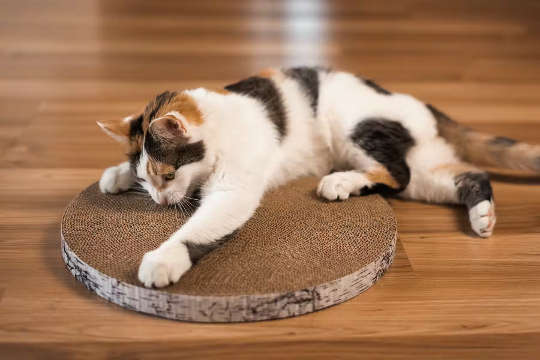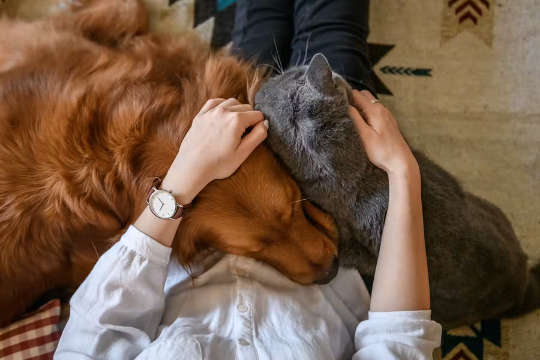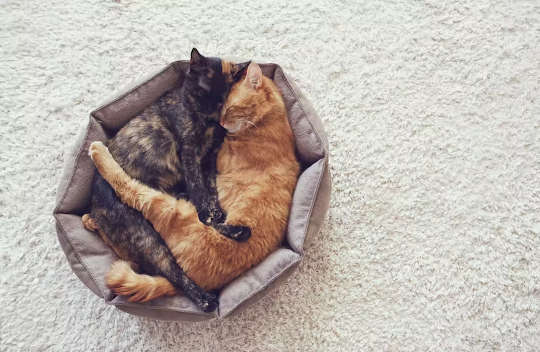Many people choose to live with a cat for companionship. As a social species, companionship is something we often crave. But this cannot necessarily be said of our feline friends. Domestic cats evolved from a largely solitary species, defending their territory from other cats.
Although modern-day cats can live together in friendly groups (when there are enough resources to go around), bonds generally only develop between cats who are related or grow up together. It is natural for cats to feel threatened by unfamiliar cats. Owners should consider whether adding another cat to their home is really in their cat’s best interest, especially if they are generally more of a timid cat.
If you’re set on adding another cat to your home, plan the introduction carefully.
Prepare for your new cat before you bring them home. Set aside a room for them, making sure they have at least two comfortable sleeping areas, a water bowl, a feeding area, scratching post and toys. Provide at least one litter tray (preferably two), well away from the food, water and sleeping places.
When the day comes to bring your new cat home, take them straight to “their” room. Allow them to come out of their carrier in their own time. They will be frightened if you try to pull them out. No matter how excited you are to interact with your new companion, you might need to leave the room, allowing them to explore by themselves.
Scent swapping
Your new cat needs to stay in their room for several days. This will help them settle down and allows you to introduce them to your existing cat via scent.
Scent, especially facial pheromones, helps cats identify other cats that they are bonded with and is important for maintaining bonds between cats. Swap cloths that each cat has slept on, and toys. Place these somewhere the cats will come across them in their own rooms, but away from beds, bowls and litter trays.
Neither cat should show signs of avoidance or aggression towards the cloths before you progress. Then you can directly swap scent between the cats. Stroke one cat, especially around the cheeks and area in front of the ears, and then go directly to the other cat and stroke them. Repeat in the other direction.
This will transfer the cats’ scent profiles and facial pheromones, as if they were rubbing on each other directly. Look for relaxed rubbing or nudging in return.
Longer term
Once both cats are relaxed about being stroked with your other cat’s scent on your hands, they can finally see each other and your new cat can explore the rest of your home. You can buy a plug-in diffuser that releases copies of a feline facial pheromone, which may help with the initial introductions as it has been found to reduce cat-to-cat aggression within households.
There should be lots of escape routes for the cats to move away from each other. Make sure there is a cat tower or furniture, like a bookshelf, to jump onto and that the cats can easily leave the room if they want to. Cats like to hide away if threatened and to get up high.

Each cat needs their own scratching surface to maintain good claw and muscle condition. Evgenia Terekhova/Shutterstock
Initially, shut the cat you adopted first away in a separate room and allow your new cat out of theirs to explore. Once they are familiar with the layout of the house and where escape routes and safe places are, you can let your other cat out. Supervise the cats and be ready to intervene if tensions start to mount.
Watch for any avoidant or agonistic behaviour, such as running away and hiding, ears going back or hissing. Never punish your cat for aggressive behaviour and avoid using food to lure the cats closer together. Cats are solitary hunters and would not naturally eat in close proximity to other cats, even ones they are bonded with.
Because cats can find it challenging to form new relationships with other cats, especially as adults, your cats may never become best friends. To reduce conflict, make sure both cats can access food, water and litter trays without having to pass each other.
As a general rule, you will need to have one more of each resource than the total number of cats in the household. For example, three litter trays for a two-cat household. If your cats go outside, it may also be helpful to provide more than one entrance and exit point, as the cat flap is another common area for conflict between cats.

Cats and dogs can also form close bonds. Chendongshan/Shutterstock
Similar advice applies if you want to add another companion species to your home, such as a puppy. Introductions may be more successful if the puppy is carefully and gradually introduced before they’re 12 weeks old.
Don’t allow your puppy to chase your cat. Reward the puppy for calm behaviour. Your cat should never feel cornered and always have the choice to move away from any interaction, whether that’s with a human or non-human animal.![]()
About The Author
Jenna Kiddie, Visiting Research Fellow in Animal Behaviour, University of Cumbria
This article is republished from The Conversation under a Creative Commons license. Read the original article.
Books on Pets from Amazon's Best Sellers list
"The Beginner's Guide to Dog Agility"
by Laurie Leach
This book is a comprehensive guide to dog agility, including training techniques, equipment, and competition rules. The book includes step-by-step instructions for training and competing in agility, as well as advice for selecting the right dog and equipment.
Click for more info or to order
"Zak George's Dog Training Revolution: The Complete Guide to Raising the Perfect Pet with Love"
by Zak George and Dina Roth Port
In this book, Zak George offers a comprehensive guide to dog training, including positive reinforcement techniques and advice for addressing common behavior issues. The book also includes information on selecting the right dog and preparing for the arrival of a new pet.
Click for more info or to order
"The Genius of Dogs: How Dogs Are Smarter than You Think"
by Brian Hare and Vanessa Woods
In this book, authors Brian Hare and Vanessa Woods explore the cognitive abilities of dogs and their unique relationship with humans. The book includes information on the science behind dog intelligence, as well as tips for enhancing the bond between dogs and their owners.
Click for more info or to order
"The Happy Puppy Handbook: Your Definitive Guide to Puppy Care and Early Training"
by Pippa Mattinson
This book is a comprehensive guide to puppy care and early training, including advice for selecting the right puppy, training techniques, and health and nutrition information. The book also includes tips for socializing puppies and preparing for their arrival.
Click for more info or to order

























